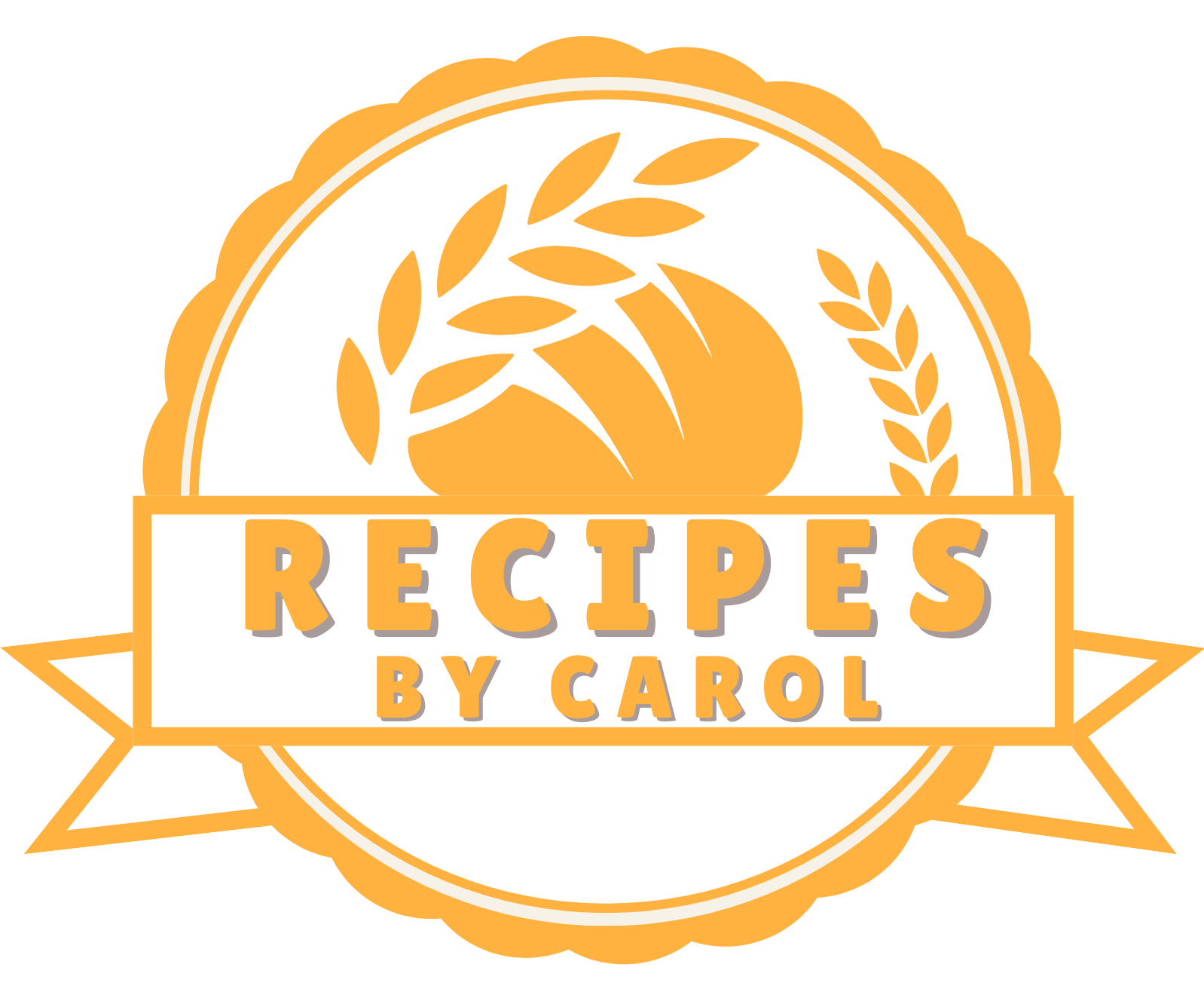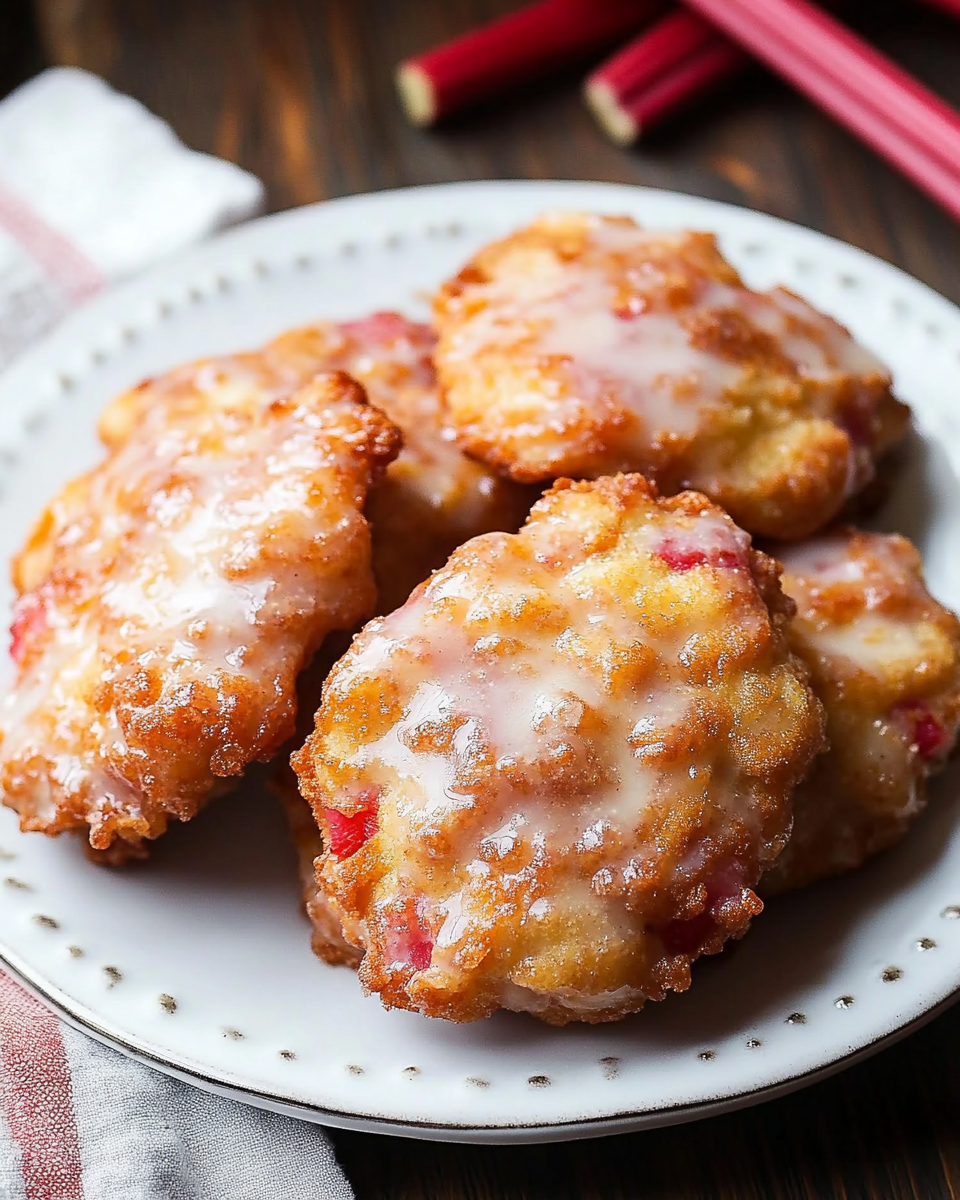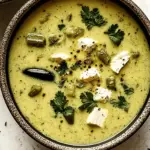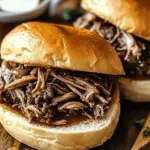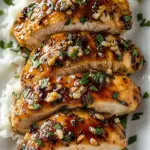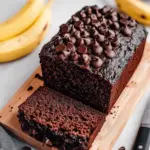The Baked Rhubarb Fritters are a sweet springtime treat that blend tart chunks of fresh rhubarb with the warmth of cinnamon and cardamom. Finished under the broiler with a crackly glaze, each bite is both soft and crunchy a delightful contrast that melts in your mouth.
Whether you’re serving these for a relaxed weekend brunch or a cozy coffee break, they offer comfort and freshness in every bite. They’re also easy to prepare, using pantry staples and minimal prep time. A rustic, no-fuss pastry that brings seasonal fruit to life.
Full Recipe:
Ingredients
Dry
-
2 cups (260 g) all-purpose flour
-
¼ cup (50 g) granulated sugar
-
2 tsp baking powder
-
½ tsp ground cinnamon
-
½ tsp fine salt
Wet
-
2 large eggs, room-temperature
-
½ cup (120 ml) milk (dairy or unsweetened almond)
-
¼ cup (60 g) plain Greek yogurt
-
2 Tbsp melted unsalted butter or neutral oil – adds the richness you’d normally get from frying
-
1 tsp pure vanilla extract
Mix-ins
-
1 ½ cups finely chopped fresh rhubarb (¼-inch pieces; pat dry if very wet)
Vanilla glaze
-
1 cup (120 g) powdered sugar, sifted
-
1–2 Tbsp milk
-
½ tsp vanilla extract
Equipment
-
Rimmed baking sheet (approx. 13 × 18 in / 33 × 46 cm)
-
Parchment paper or silicone mat
-
2 Tbsp cookie scoop (or two spoons)
Directions
-
Prep oven & pan
-
Place an empty rimmed baking sheet on the center rack.
-
Preheat oven to 400 °F / 200 °C (hot oven = quick browning).
-
Line a second, room-temperature sheet with parchment; lightly mist with cooking spray.
-
-
Whisk dry ingredients in a large bowl: flour, sugar, baking powder, cinnamon, salt.
-
Blend wet ingredients in a separate bowl until smooth: eggs, milk, yogurt, melted butter (or oil), vanilla.
-
Combine wet into dry just until no powdery streaks remain. The batter will be thick—like drop-biscuit dough.
-
Fold in rhubarb gently to keep the chunks intact.
-
Portion & flatten
-
Using the scoop, drop 2-Tbsp mounds on the prepared (cool) parchment, spacing about 2 in/5 cm apart.
-
With damp fingers, press each mound to ~½ in (1.3 cm) thick; this helps them bake through evenly.
-
-
Bake on hot sheet
-
Slide parchment sheet onto the pre-heated pan.
-
Bake 8 minutes, rotate, then bake 6–8 minutes more until tops are golden and the edges feel crisp.
-
-
Cool briefly on pan 3 minutes, then transfer fritters to a wire rack set over parchment.
-
Glaze
-
Whisk powdered sugar with 1 Tbsp milk and vanilla; add a splash more milk for a pourable consistency.
-
Spoon or drizzle over warm fritters; glaze sets in about 10 minutes.
-
Yields & nutrition (approx.)
Makes 12 fritters · ~200 kcal each | Fat 8 g | Sat 4 g | Carbs 29 g | Sugars 16 g | Protein 4 g
Prep Time: 15 minutes | Cooking Time: 15 minutes | Total Time: 30 minutes
Kcal: 260 kcal (approximate) | Servings: 8 fritters
The Delight of Baked Rhubarb Fritters: A Cozy Springtime Treat
Spring has a way of waking up the kitchen. After months of rich, heavy winter fare, the arrival of tart, bright rhubarb in farmer’s markets and gardens feels like nature’s signal to lighten things up while still savoring every bite. That’s where baked rhubarb fritters come in: the perfect way to celebrate the change of season with a cozy, gently spiced treat that’s lighter than fried pastries but just as indulgent.
What Are Baked Fritters?
When most people hear “fritter,” their minds go to something fried perhaps a sweet, sticky apple fritter from a donut shop, or a savory corn fritter crisped up in a pan. But baked fritters are an entirely different experience. They borrow from the texture of scones, the look of rustic cookies, and the joy of quick, drop style baking.
These fritters don’t need yeast or deep frying, and they come together with basic pantry staples. The result is a golden, craggy pastry with a tender interior that showcases chunks of fresh rhubarb. A simple vanilla glaze broiled to caramel perfection adds texture and sweetness that crackles slightly as you bite in.
If you’re looking for a rustic, homemade bake that doesn’t require special equipment or fussy dough, baked fritters hit the mark. And with rhubarb involved, they become something special.
Rhubarb: The Star of Spring
Rhubarb is one of those ingredients that makes bakers and gardeners perk up in early spring. Technically a vegetable (though often treated like fruit), rhubarb brings a naturally tart flavor that balances beautifully with sugar, butter, and spices in baked goods. Its rosy-pink stalks are unmistakable, and they add a pop of color that’s particularly welcome in spring pastries.
Fresh rhubarb is typically in season from April to June, making it one of the first homegrown ingredients many people cook with after winter. In baked fritters, rhubarb softens just enough in the oven to become jammy, but still retains its tartness and structure. Combined with warm spices like cinnamon and cardamom, the flavor is sweet, tangy, and comforting all at once.
A Flavor and Texture Story
Baked rhubarb fritters offer a satisfying balance of textures. The interior is soft and slightly fluffy, similar to a scone, but looser and more casual. The rhubarb gives each bite a little burst of moisture and acidity, preventing the fritter from feeling dry or overly sweet. What really sets these apart, though, is the two-step glazing process.
Once the fritters are baked, they’re brushed with a thin vanilla glaze and placed under the broiler. This causes the glaze to bubble and caramelize slightly, forming a light crust on the top. A second glaze brushing adds that finishing touch a glossy, sweet shell that contrasts beautifully with the pastry’s soft interior and rustic edges.
The result is a fritter that’s visually charming (think uneven peaks and valleys, with pockets of glaze pooled in the crevices), texturally rich, and flavorfully layered.
How Fritters Compare to Other Bakes
If you’re wondering whether fritters are just scones by another name, the answer is: not quite. Scones are more structured, usually rolled and cut, and often served plain or with clotted cream and jam. Muffins are softer and more uniform, often baked in liners and domed in shape.
Fritters, especially baked ones like these, lean more rustic. You scoop the dough onto a sheet no shaping, no rolling and the edges crisp up slightly in the oven. They look homemade in the best way possible. Their form is irregular and inviting, like something you’d find cooling on your grandmother’s kitchen counter.
Customizing Your Fritters
One of the joys of this recipe is its flexibility. Rhubarb is the hero here, but it plays well with others. If you want to experiment, try mixing in other fruits:
-
Strawberries: A classic pairing with rhubarb for a sweet-tart combo.
-
Apples: Especially good in fall when rhubarb is hard to find.
-
Peaches or nectarines: These add juiciness and mellow flavor.
You can also play with spices. The combination of cinnamon and cardamom gives a warm, slightly exotic note that complements rhubarb well, but you could also try:
-
Ground ginger for a little kick
-
Nutmeg for extra warmth
-
Orange zest for citrus brightness
For those who like texture, consider adding chopped nuts like pecans or walnuts to the batter, or sprinkling them on top before broiling. They’ll toast up nicely under the glaze.
When to Serve and How to Enjoy
Baked rhubarb fritters are a versatile treat. Serve them warm for breakfast with a cup of coffee or tea, or include them on a brunch spread alongside scrambled eggs, fruit salad, and yogurt. They also make an excellent afternoon snack perfect with a drizzle of honey or a pat of soft butter if you’re feeling extra indulgent.
Because they’re best the day they’re baked, these fritters are ideal for casual entertaining or weekend family breakfasts. They’re quick enough to make on a whim, but unique enough to feel like a special occasion.
Pair them with:
-
Black coffee or espresso to balance the sweetness
-
Chai or cinnamon-spiced tea to echo the warming spices
-
Cold milk or oat milk for a comforting, nostalgic feel
Tips for Fritter Success
Even though this recipe is wonderfully simple, a few thoughtful tips can help you get the best results:
-
Use cold butter. Just like with scones or biscuits, cutting cold butter into the flour creates pockets of steam during baking, giving the fritters a tender, flaky texture.
-
Don’t overmix. Stir the batter until just combined. Overmixing can make the fritters dense.
-
Stick with all-purpose or white whole wheat flour. While whole wheat flour adds nutrition, it can make the fritters too heavy and alter the flavor.
-
Monitor the broiler closely. Glaze caramelizes quickly check after 2 minutes to avoid burning.
-
Eat fresh. These fritters are best the day they’re baked, though you can store leftovers in an airtight container for a day or two.
Why We Love This Recipe
There’s something deeply comforting about a recipe that invites imperfection. These baked rhubarb fritters are rustic, forgiving, and welcoming to both new and seasoned bakers. They don’t require a stand mixer or a pastry blender just a bowl, a spoon, and a love for seasonal flavors.
Rhubarb, often underappreciated, really gets to shine here. Its brightness cuts through the sweetness of the glaze, offering depth and contrast that keeps each bite interesting. And the warm notes of cinnamon and cardamom make the whole kitchen smell like spring mornings and cozy weekends.
Conclusion:
Baked rhubarb fritters are more than a recipe they’re a celebration of seasonality, simplicity, and the joy of home baking. They remind us that baking doesn’t have to be elaborate to be memorable. With their caramelized tops, tender centers, and bursts of tart rhubarb, these fritters are a delightful way to embrace spring’s freshest offerings.
Whether you’re baking for family, friends, or simply to treat yourself, this recipe offers the kind of feel good flavor that lingers in memory. Make a batch while rhubarb is in season you won’t regret it.
